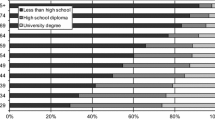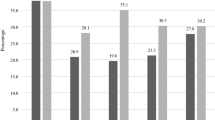Abstract
In Sweden, as in other industrialized countries, a decades-old decline in fertility rates has been accompanied by a rise in the age at first birth. In contrast to other industrialized countries, however, fertility rates rose sharply in the 1980s before plummeting in the 1990s. In this paper we apply hazard regression to data from the 1992 Swedish Family Survey, supplemented by annual earnings data linked to individuals and by annual time series of national-level economic indicators, to investigate the predictors of the timing of the first birth of women in Sweden since the mid-1960s. The discovery that both individual characteristics and aggregate-level factors influence the timing of the first birth casts light on both the continuing trend of postponement of the first birth and annual fluctuations in first-birth rates.
Similar content being viewed by others
References
Aitkin, M., Anderson, D., Francis, B. and Hinde, J., 1989. Statistical Modelling in GLIM. Clarendon Press, Oxford.
Blackburn, McKinley L., Bloom, D. E. and Neumark, D., 1993. 'Fertility timing, wages, and human capital,' Journal of Population Economics 6: 3–30.
Blossfeld, H.-P. (ed), 1995. The New Role of Women. Family Formation in Modern Societies. Westview Press, Boulder.
Blossfeld, H.-P. and Huinink, J., 1991. 'Human capital investments or norms of role transition? How women's schooling and career affect the process of family formation,' American Journal of Sociology 97: 143–168.
Bracher, M. and Santow, G., 1998. 'Economic independence and union formation in Sweden,' Population Studies 52: 275–294.
Dencik, L., 1995. 'Modern childhood in the Nordic countries: “Dual socialisation” and its implications,' in L. Chisholm et al. (eds), Growing Up in Europe: Contemporary Horizons in Childhood and Youth Studies. Walter de Gruyter, Berlin, 105–119.
European Commission, 1994. Employment in Europe — 1994. Luxembourg: Office for Official Publications of the European Communities.
Hoem, B., 1992. 'Early phases of family formation in contemporary Sweden,' in M.K. Rosenheim and M.F. Testa (eds), Early Parenthood and Coming of Age in the 1990s. Rutgers University Press, New Brunswick, 183–199.
Hoem, B., 1995. 'Kvinnors och mäns liv. En rapport från SCB:s undersökning om Familj och arbete.' Statistiska centralbyrån, Stockholm, 4 parts.
Hoem, B. and Hoem, J. M., 1996. 'Sweden's family policies and roller-coaster fertility,' Journal of Population Problems 52: 1–22.
James, W. J., 1990. 'Seasonal variation in human births,' Journal of Biosocial Science 22: 113–119.
Jonsson, L., 1975. 'Law and fertility in Sweden,' in M. Kirk, M. Livi Bacci and E. Szabady (eds), Law and Fertility in Europe: A study of legislation directly or indirectly affecting fertility in Europe. Ordina, Liège.
Kravdal, Ø., 1994. 'The importance of economic activity, economic potential and economic resources for the timing of first births in Norway,' Population Studies 48: 249–267.
Lam, D. A. and Miron, J. A., 1996. 'The effects of temperature on human fertility,' Demography 33: 291–305.
Lesthaeghe, R., 1983. 'A century of demographic and cultural change in Western Europe: An exploration of underlying dimensions,' Population and Development Review 9: 411–435.
Lindbeck, A., 1997. 'The Swedish experiment,' Journal of Economic Literature 35: 1273–1319.
Meisaari-Polsa, T. and Söderström, L., 1995. 'Recent Swedish fertility changes in perspective,' in C. Lundh (ed.), Demography, Economy and Welfare. Lund University Press, Lund, 11–27.
Murphy, M., 1992. 'The progression to the third birth in Sweden,' in J. Trussell, R. Hankinson and J. Tilton (eds), Demographic Applications of Event History Analysis. Clarendon Press, Oxford, 141–156.
Preston, S. H., 1986. 'Changing values and falling birth rates,' in K. Davis, M. S. Bernstam and R. Ricardo-Campbell (eds), Below-Replacement Fertility in Industrial Societies. Causes, Consequences, Policies. Population and Development Review, Supplement to Vol. 12, 176–195.
Rindfuss, R. R., Bumpass, L. and St. John, C., 1980 'Education and fertility: Implications for the roles women occupy,' American Sociological Review 45: 431–447.
Rindfuss, R. R., Morgan, S. P. and Swicegood, G., 1988. First Births in America: Changes in the Timing of Parenthood. University of California Press, Berkeley.
Rönsen, M. and Sundström, M., 1996. 'Maternal employment in Scandinavia: A comparison of the after-birth employment activity of Norwegian and Swedish women,' Journal of Population Economics 9: 267–285.
Santow, G. and Bracher, M., 1999. 'Explaining trends in teenage childbearing in Sweden,' Studies in Family Planning 30: 169–182.
Sundström, M. and Stafford, F., 1992. 'Female labour force participation, fertility and public policy,' European Journal of Population 8: 199–215.
Van de Kaa, D. J., 1987. 'Europe's second demographic transition,' Population Bulletin 42.
Walldén, M., 1994. 'Om årstidsvariationer i födelsetal,' Unpublished. Department of Sociology, Stockholm University.
Author information
Authors and Affiliations
Corresponding author
Rights and permissions
About this article
Cite this article
Santow, G., Bracher Deferment of the First Birth and Fluctuating Fertility in Sweden. European Journal of Population 17, 343–363 (2001). https://doi.org/10.1023/A:1012527623350
Issue Date:
DOI: https://doi.org/10.1023/A:1012527623350




